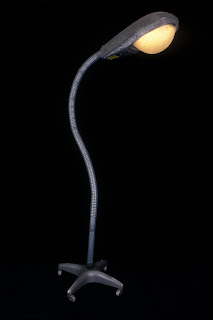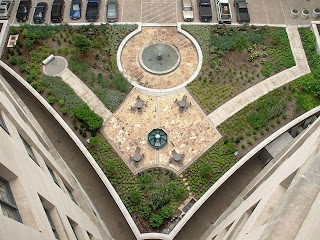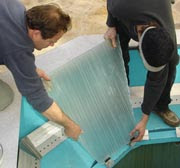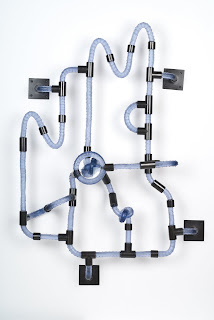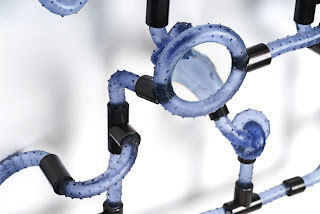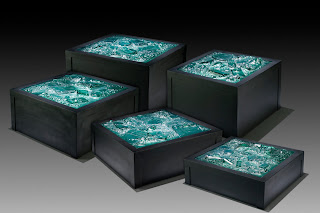>
The James Renwick Alliance is hosting a presentation of how Safeway supermarkets support American Craft with their new public art project in Bethsda, MD. The process and inspirations of the artwork will be reviewed in the talk. Find out about tickets by clicking on the link!
The JRA is an independent national nonprofit organization dedicated to advancing scholarship and education on contemporary American craft, to supporting activities directed toward this purpose, and to encouraging connoisseurship and collecting. The Alliance assists the Smithsonian American Art Museum’s Renwick Gallery in adding to its permanent collection of American craft of artistic significance and superior workmanship, supports scholarly research in contemporary American craft, sponsors public educational activities, and pursues other activities in support of the studio craft movement.
More info on the event:
Ticket cost is a tax deductible nonrefundable contribution of $15 per person and space is limited. Please RSVP to the JRA office by phone or email (301.907.3888 or admin@jra.org) by 5 p.m. on Monday, December 5 by 5 p.m.
Making Functional Art From Recycled Materials Class
>
The Eco-Tables class- where the students create the tables using recycled materials (both reclaimed steel & glass) just completed – here are some photos from the class!
The class first creating the table-tops, working with salvaged and recycled float glass.
After fusing the recycled glass, the tops were coldworked and made smooth.
Erwin Timmers – DC’s leading “Green-artist” outlines what is required to make the metal work support. Some students are overwhelmed.
Erwin outlines step-by-step the procedures to cut, weld and grind smooth the steelwork.
Teaching Assistant Laurie Brown supervises the metal working.
Soon, tables are marching out from the coldshop.
The students – some who have never cut glass or welded before – are amazed at their artwork and celebrate their progress. “What’s next?” is on each student’s mind.
The new class schedule is due out soon – Keep posted for the listing!
Installation of Safeway Supermarket Public Art Project
>
 Safeway Bethesda site construction photo August 22, 2011
Safeway Bethesda site construction photo August 22, 2011
Earlier posts on the Washington Glass School Blog featured the design and fabrication of Safeway supermaket’s first public art project – located here in Bethesda and created by the Washington Glass Studio.
Installation of the public artwork has begun. The cast glass panels were made from recycled glass taken from the original supermarket during the demolition phase, and the salvaged glass was cast in a bas-relief method to create translucent panels that referenced fresh herbs – perfect for a new LEED Certified building that would house the trendy Safeway supermarket.
Erwin Timmers installs the cast glass & steel panels.
Evan Morgan affixes the glass panels to the steel framework.
Interior view of the artwork – looking out towards Bradley Ave. Bethesda, MD.
The concept of the panels was to have the artwork allow openings to allow the interior and exterior blur – approx 25% of each building bay is open to allow air flow.
Roche Constructors are the builders of the project – and they have a Safeway webcam. Click on the link and at the top is a time-lapse feature that allows one to see the project’s demo-to-current construction status. Click HERE to jump to the Roche webcam site.
UPDATE: Click HERE to jump to finished project images.
Kris Coronado Dishes on the Story Behind Erwin Timmers
>Kris Coronado’s article about Erwin Timmers and his eco-art that uses recycled glass and salvaged components for his artwork and the classes he teaches was in the Washington Post magazine this weekend.
Kris writes more about the experience and has more images on her blog – click HERE to jump to her blog.
Washington Post Magazine Features Environmental Artist Erwin Timmers
>

The Washington Post Sunday Magazine has a great article about how Erwin Timmers is able to source artwork from ordinary cast-offs. Washington Post writer Kris Coronado interviewed Erwin for the “Closer Inspection” column of the magazine, and spent the day at the school with photographer Ben Tankersley, wanting to know the story of seemingly every piece of glass they found.

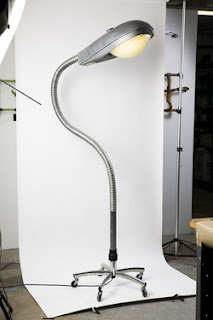
Washington Post’s Ben Tankersley sets up an impromptu photo studio for Erwin Timmers work
Kris writes: “Erwin Timmers, artist and co-founder of the Washington Glass School in Mount Rainier, has taken recycling to heart. “That’s my carbon footprint,” he jokes, pointing to a depression of his boot set in the large slab of repurposed green glass hung on the wall. “I like using objects that everybody recognizes that are everyday, common items,” he says, “that people don’t really realize what value they have … until they end up in the trash heap.”

Washington Post Magazine “Closer Inspection” Sunday, August 21, 2011
Glass Sparks: Erwin Timmers
>
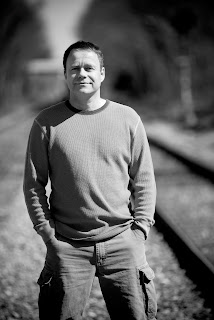
In honor of Earth Day, today’s artist profile is about eco-artist Erwin Timmers.
Erwin has become one of the area’s leading “green artists”. Recycling, waste, the environment and how they relate to society are recurring themes in his work – all of which he blames on his Dutch heritage. Erwin’s main medium is one of the least recycled building materials; float glass or window glass, and he has had to develop new techniques to work with this material.
Originally from Amsterdam, Erwin Timmers moved to California, graduating from Santa Monica College for Design Art and Architecture in 1995. Erwin’s artwork and sculpture has always incorporated recycled materials, and often integrated lighting elements. In 1999 he came to the Washington DC area and along with a new home came a new passion: Glass – creating the perfect marriage of metal and light. Combining this with found and recycled metal, his work carries strong environmental themes.
“Mr Cobrahead”, recycled materials, cast recycled glass
“Love Me, Love Me Not”, recycled steel, cast recycled glass, neon
Seeking to further his knowledge on using recycled glass, Erwin soon found there were few local options that taught glass techniques and recycled glass processes. And with little information available, Erwin became a pioneer in the field, developing his own kiln schedules. Fate would have it that he met up with Tim Tate, who was then starting the foundations for a glass school in Washington, DC. With his experimental approach and his easygoing, accessible teaching attitude, Erwin and Tim started the Washington Glass School in 2001. Erwin developed a number of courses that integrate his love of the materials and his environmental philosophies. His sustainable design knowledge has been sought by other glass schools, and besides courses here at the Washington Glass School, he has been teaching across the country, spreading the word about eco-friendly art.
Erwin Timmers chats with Italian glass Maestro Lino Tagliapietra.
Erwin has also become a leading consultant in LEED Certified artwork. He has received multiple public art commissions and is also featured in numerous private collections. The EPA had commissioned Erwin and the Washington Glass Studio to create an educational sculpture for the courtyard at the EPA’s Washington, DC headquarters.
Low-Impact Demonstration Project, Ariel Rios Courtyard, Washington, DC. Quinn Evans Architects, John Shorb Landscaping
Erwin Timmers and Evan Morgan installing recycled glass panels.
“Self Scrutiny”, cast recyled glass
photos: Anything Photographic
“Self Scrutiny” detail
Erwin’s environmental focused artwork has found an audience, from Miami International Art Fair to local and regional art gallery shows, including and upcoming engagement at Project 4 Gallery this summer. His work showcases the possibility and beauty of recycled material, while encouraging the viewer to consider his or her environmental impact.
Using glass salvaged from a Virginia office building refurbishment, disposable technology and ephemera from recent decades are expressed as though discovered from a future archaeological dig.
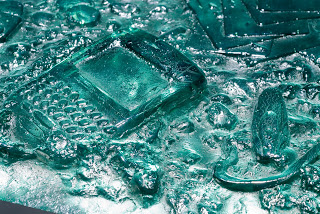
“What We Leave Behind” detail, 2000’s
photo by Anything Photographic
Erwin will be one of the artists featured in the upcoming LongView Gallery show Artists of the Washington Glass School: The First Ten Years.
Washington Glass School: The First 10 Years
LongView Gallery
1234 9th Street, NW, Washington, DC May 19 – June 19,2011
Artist Reception, May 19th, 6:30-8:30 PM
For other glass artist profiles
Extra! Extra! Read All About It!
>
Kris Coronado interviews Erwin Timmers
The Washington Post Magazine columnist Kris Coronado spent the day in the Washington Glass School this week, interviewing Erwin Timmers for an upcoming article on recycling and environmentally conscious artwork.
Above & Below: Washington Post photographer Benjamin Tankersley photos artwork made from recycled glass components.
Erwin talked wth Kris about his background in sustainable design, and how the growing awareness of the limits to our natural resources has led to a greater appreciation and interest in work made with environmentally responsible materials. Post photographer Benjamin Tankersley set up a full photo backdrop to properly document Erwin’s eco-artwork. The Washington Post article is due out in the paper in early June.
Erwin Timmers Goes To The Queen City
>
Our “guru of green“, Erwin Timmers will be teaching at Cincinnati’s Brazee Street School of Glass, spreading the word of recycled glass artwork. This April 16 & 17, Erwin will have the students explore using recycled glass to make sculptural pieces, architectural elements and tableware. The workshop will cover a variety of techniques including fusing, casting, and slumping.
This April 16 & 17, Erwin will have the students explore using recycled glass to make sculptural pieces, architectural elements and tableware. The workshop will cover a variety of techniques including fusing, casting, and slumping.
Click HERE to jump to Brazee Street Studios website.
Production of Cast Art Glass for Public Art Project
>Readers of the WGS Blog are familiar with the Public Art Project currently underway for Safeway Supermarket’s new LEED Certified building in Bethesda, MD.
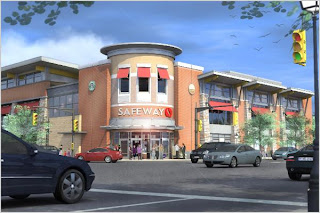
Construction of the steel framework is underway & the kilns have been firing nonstop to make the “herb-leaf” inspired bas-relief kilnformed casting.

Layout sketch of a typical architectural bay.
Matt Duffy & Erwin Timmers check the clarity of the glass (mind you, it must not be too much and not be too little – it needs to be just right.)
Erwin check the glass for evenness of form and to make sure the panels will lay flat within the steel framework.
We will post other photos of the process soon!
UPDATE: Click HERE to jump to photos of finished project.
Recycled Glass Art Workshop
>
What We Leave Behind (detail) Erwin Timmers
cast recycled glass
Renowned Eco Artist Erwin Timmers will lead the recycled glass Going Green workshop this coming President’s Day Weekend.
Green up your life by doing something creative to help the environment!
This class is an exploration into using recycled glass to make sculptural pieces, architectural elements, and tableware. The class will delve into multiple techniques, including casting, fusing and slumping. Glass chemistry, coloration, and firing temperatures will be explained for each particular application. It is a fantastic way to learn aspects of any warm glass work while focusing on recycling!
Once you start down the path of recycled glass, you will see more and more opportunities for experimentation around you. No prior experience is necessary – you are encouraged to bring in materials you’d like to try…and you will leave with several very cool items!
Erwin Timmers
Going Green Class 1043
Dates Sat/Sun/Mon on Feb 19, 20 & 21
Time 10am – 4pm
Tuition $400

